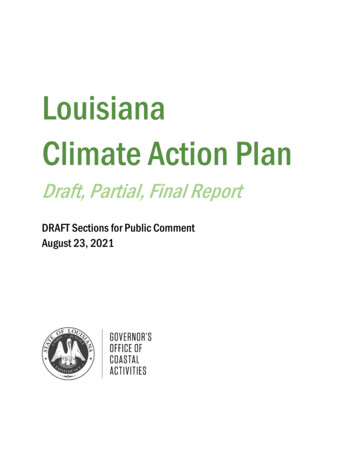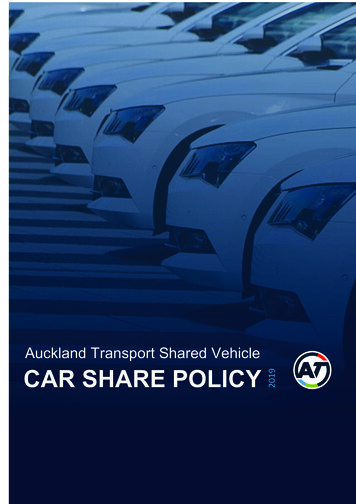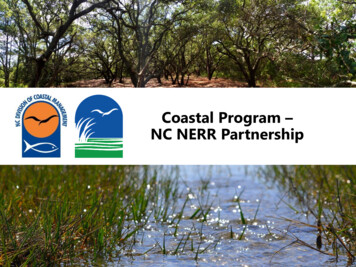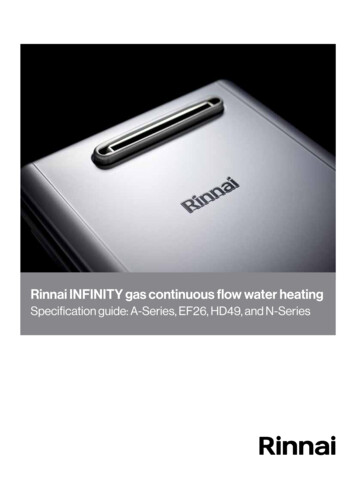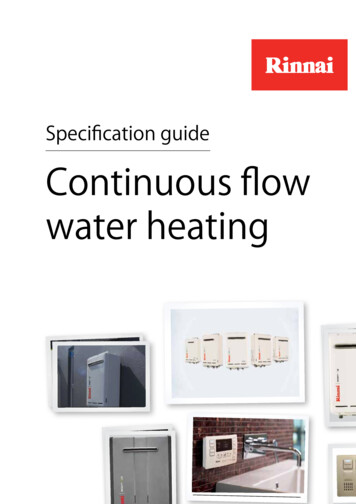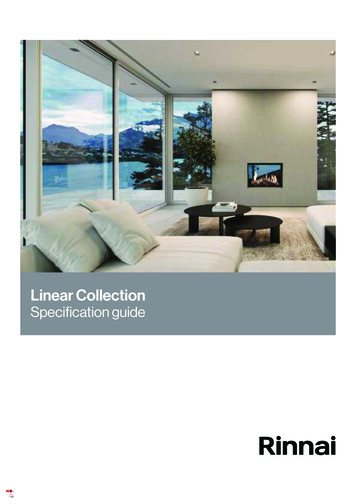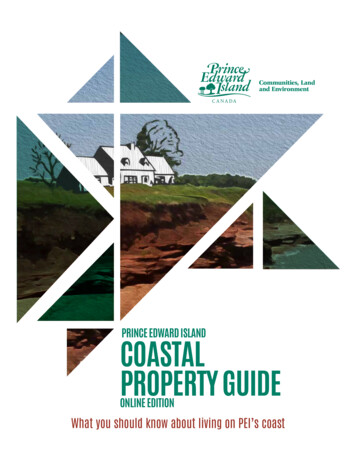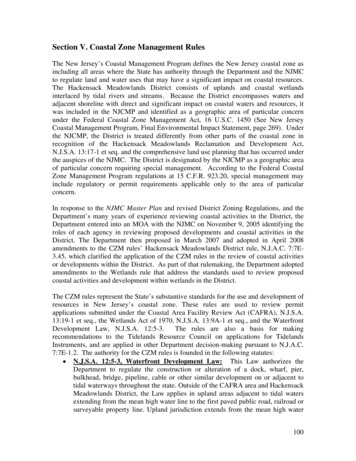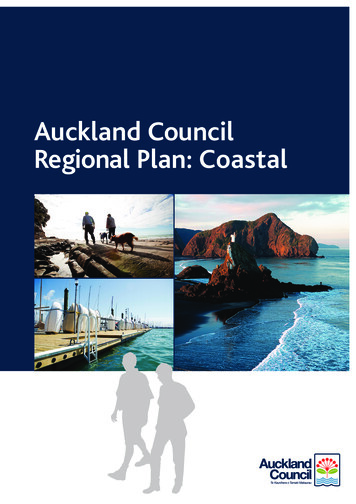
Transcription
Auckland CouncilRegional Plan: Coastal
NOTATION ESTABLISHES NEW AQUACULTUREMANAGEMENT AREAThis notation to the Auckland Regional Plan: Coastal (ARP:C) establishes the date upon which a new AquacultureManagement Area (AMA) is created in the southern Kaipara harbour.New Aquaculture Management AreaOn 19 March 2008 the Ministry of Fisheries issued marine farming permit MF/905 to Biomarine Limited. Thetype of farming permitted and area affected is the same as that in coastal permits 25564 and 25565 (previouslyapproved by the Environment Court and the Minister of Conservation). Section 44 of the Aquaculture Reform(Repeals and Transitional Provisions) Act 2004 (the ARA) requires the Auckland Regional Council to note onthe ARP:C the details of this determination. From the date of this notation the relevant area of the previouslyestablished ‘interim AMA’ becomes an AMA.The details of the determination are:–Approved Area – 76 hectares (approximately)Species able to be farmed – Pacific Oysters (Crassostrea gigas)Location of Approved Area – The area situated 3.1 kilometres south west of Orongo Point, Southern KaiparaHarbour and defined by the coordinates shown in coastal permits 25564 and 25565, being:Approximate Map Reference NZMS 260 Q09:Corner Point 1Corner Point 2Corner Point 3Corner Point 426 29595 E26 29305 E26 28079 E26 28369 E65 29049 N65 28628 N65 29472 N65 29893 NLatitude and LongitudeCorner Point 1Corner Point 2Corner Point 3Corner Point 436º 25’56.917”S36º 26’10.722”S36º 25’44.000”S36º 25’30.196”S174º 19’42.087”E174º 19’30.727”E174º 18’ 41.000”E174º 18’52.361”EDate of Notation;– Thursday 10th April 2008
NOTES ON THE VARIATIONSThe Auckland Regional Plan: Coastal is subject to Variations 2 – 6. Where a provision is affected by these Variations,the provision appears in shaded text. Struck out shaded text indicates provisions deleted by Variations 2 – 6, whileunderlined shaded text indicates a provision inserted by Variations 2 – 6.The Variations make amendments to Chapters 1, 2, 10, 11, and 22, the Definitions, Schedule 9and Appendix I of the plan text.Variations 2 – 6 also add Aquaculture Management Areas to Map Series 1.Where a Plan provision is affected by Variation(s), it has not been made operative, and reference mustbe made as well to the provisions of the Auckland Transitional Regional Coastal Plan until the Variation(s)is resolved.
Auckland Council Regional Plan:Coastal Variations, Plan Changesand Other AmendmentsAs at 27 September 2013VariationsSubjectVariation 1Stormwater and wastewater network discharges Operative 27 September 2013[consistency with provisions of Auckland CouncilRegional Plan: Air Land Water]Variation 2Aquaculture provisionsOn-hold while a new aquaculturepolicy framework is preparedVariation 3Aquaculture Management Areas – KaiparaWithdrawnVariation 4Aquaculture Management Areas– Mahurangi Harbour and Kawau IslandOn-hold while a new aquaculturepolicy framework is preparedVariation 5Aquaculture Management Areas– Great Barrier IslandOn-hold while a new aquaculturepolicy framework is preparedVariation 6Aquaculture Management Areas– Waiheke Island and Wairoa Bay / ClevedonOn-hold while a new aquaculturepolicy framework is preparedPlan ChangeSubjectStatusPlan Change 1Coastal Mooring Management Areas– Rakino Island [Private Plan Change]Operative 10 March 2008Plan Change 2Coastal Occupation ChargingWithdrawn 19 December 2011Plan Change 3Wynyard QuarterOperative 19 October 2011Plan Change 4Mangrove ManagementOperative 7 March 2011Plan NotationSubjectStatusAquaculture Management Interim AMA becomes AMA – Southern KaiparaArea (AMA)(Biomarine Limited oyster farm)Plan Amendment SubjectStatusNew Zealand CoastalPolicy Statement 2010Policy 29Removal of Restricted Coastal Activities (RCA’s)and references to RCA’s in theAuckland Regional Plan: Coastal.StatusNotation added 10 April 2008Changes made 1 March 2011
iContentsPart 1IntroductionChapter 61.71.81.91.101.111.121.13Part IIPlan OutlineAreas to which the Plan AppliesThe resource Management Act 1991How the Plan Promotes SustainableManagement of the Coastal EnvironmentPlan StructurePolicy FrameworkOther StatutesAdministrative FrameworkInternational ObligationsOwnership of the Coastal Marine AreaCategories of ActivitiesApplications for ConsentNotification or Obtaining the Written Approval ofAffected Persons for Coastal Permit 181–191–201–20Management AreasChapter 2Management Areas and Areas of SignificantConservation –62–6IntroductionPort Management AreasAuckland Airport Management AreaDefence Management and Exercise AreasMarina Management AreasMooring Management AreasAquaculture Management AreasSpecial Activity AreasCoastal Protection AreasTangata Whenua Management AreasGeneral Management AreaAreas of Significant Conservation ValuePart III ValuesChapter 3Chapter 4Chapter 5Chapter 6Chapter 7Chapter 8Chapter 9Auckland Regional CouncilNatural CharacterLandscapeNatural Features and EcosystemsNga Take Takutai Tuturu Mo Tangata Whenua(Coastal Matters of Significance to Tangata Whenua)Public AccessCultural HeritageSubdivision, Use and Development3–1 to 3–34–1 to 4–55–1 to 5–66–1 to 6–47–1 to 7–38–1 to 8–49–1 to 9–3
iiPart IV Use and DevelopmentChapter 10General (Objectives and Policies genarallyapplying to all use and Development)10–1 to 10–8Chapter 11 Activities11–1 to 11–5Chapter 12 Structures12–1 to 12–9Chapter 13 Reclamation and Drainage13–1 to 13–6Chapter 14 Disturbance of Foreshore and Seabed I Extraction 14–1 to 14–6Chapter 15 Disturbance of Foreshore and Seabed II Dredging 15–1 to 15–8Chapter 16 Disturbance of Foreshore and Seabed III OtherDisturbances16–1 to 16–9Chapter 17 Disposal and Deposition17–1 to 17–8Chapter 18 Planting and Introduction of Plants18–1 to 18–13Chapter 19 Taking, Use, Damming or Diverting Water19–1 to 19–7Chapter 20 Discharges of Contaminants20–1 to 20–17Chapter 21 Natural Coastal Hazards21–1 to 21–5Chapter 22 Aquaculture22–1 to 22–19Chapter 23 Marinas23–1 to 23–6Chapter 24 Moorings24–1 to 24–5Chapter 25 Ports Overview and General Provisions25–1 to 25–10Chapter 25a Other Port Facility Management Areas25a–1 to 25a–5Chapter 26 Port Management Areas 1a and 1b26–1 to 26–2Chapter 27 Port Management Area 1c27–1 to 27–3Chapter 28 Port Management Area 228–1 to 28–6Chapter 29 Port Management Area 329–1 to 29–7Chapter 30 Port Management Areas 4a, 4b, And 4c30–1 to 30–5Chapter 31 Port Management Area 531–1 to 31–7Chapter 32 Auckland Airport Management Area32–1 to 32–5Chapter 33 Defence33–1 to 33–10Chapter 34 Signs34–1 to 34–7Chapter 35 Noise35–1 to 35–6Part VConsent ProcessingChapter 36Chapter 37Chapter 38Consent ProcessingConditions of ConsentObtaining Environmental Benefits36–1 to 36–537–138–1 to 38–3Part VI Monitoring and ReviewChapter 39Chapter 40MonitoringReview of and Changes to the Plan39–1 to 39–440–1Part VII Additional MattersChapter 41Chapter 42Chapter 43AdministrationExisting usesCross-boundary issues41–1 to 41–342–143–1 to 43–2Auckland Regional Council
iiiSchedules123456789Cultural Heritage Sites for PreservationCultural Heritage Sites for ProtectionCoastal Protection AreasAreas of Significant Conservation ValueMooring Management AreasAreas Adjacent to the Coastal Marine AreaAdministered by the Department of ConservationCoastal Marine Area BoundariesBoundaries of Port Management AreasAquaculture Management Area CoordinatesS1–1 to S1–2S2–1 to S2–4S3–1 to S3–28S4–1 to S4–2S5–1 to S5–2S6–1 to S6–3S7–1 to S7–9S8–1 to S8–2S9–1 to S9–4AppendicesABCEFGHIJKMarine Protected AreasA–1 to A–2AC Policies Relevant to the Regional Plan CoastalB–1 to B–3Fourth Schedule, Resource Management Act 1991C–1Landscape Values and AssessmentE–1 to E–5Resource Management (Marine Pollution)Regulations 1998F–1 to F–6Auckland International Airport Specification forObstacle Limitation SurfacesG–1 to G–3Auckland International Airport Requirements forRunway End Protection AreaH–1Maritime Safety Authority Guidelines on Applicationsfor Coastal Permits relating to Marine Farming, 2001 I–1 to I–8Urban design criteria for new developments in thecoastal marine areaJ-1 to J-2Comprehensive Coastal Management PlanK-1 to K-2DefinitionsDef–1 to Def–12List of FiguresAuckland Regional CouncilFigure 1.1:Auckland Region Coastal Marine Area1–2Figure 1.2:Structure of the Plan1–9Figure 1.3:Resource Management Act 1991 –Policy-Planning Framework1–12Figure 1.4:Administrative jurisdictions1–19Figure 19.1:Inner Coastal and Open Coastal Water Areasin the Auckland Coastal Marine Area19–3Figure 29.1:Princes Wharf: Maximum Height & Building Envelope29–6Figure 29.2:Princes Wharf: Maximum Height Elevations29–7Figure 36.1:Application process for resource consents under RMA36–4Figure G.1:Auckland International Airport Obstacle Limitation Surface G1–2Updated September 2011
ivAuckland Regional Council
Introduction – 11–1Introduction – 11.1PLAN OUTLINE1.1.1Need to Prepare a Regional Coastal PlanSection 64(1) of the Resource Management Act 1991(RMA) requires the Auckland Regional Council (ARC)to prepare a regional coastal plan for the coastalmarine area of the region, in the manner set out in theFirst Schedule of the Act.1.1.2Plan PurposeThe purpose of this Plan is to provide a framework topromote the integrated and sustainable managementof Auckland’s coastal environment. One of thefunctions of the ARC stated in section 30 of the RMAis the control of the Region’s coastal marine area, inconjunction with the Minister of Conservation.the framework within which certain uses are permittedand proposals for development can be assessed. ThePlan provides certainty for existing and potential usersof the coastal marine area by the provision of theserules.1.2AREAS TO WHICH THE PLAN APPLIES1.2.1Coastal Marine AreaSection 64(1) of the RMA states that a regional coastalplan must be prepared for the coastal marine area ofa region. Under section 2(1) of the RMA the coastalmarine area is defined as:“the foreshore, seabed, and coastal water, and theair space above the water (a)Section 63(2) of the RMA states that the purpose ofthe preparation, implementation and administration ofregional coastal plans is to assist a regional council,in conjunction with the Minister of Conservation,to achieve the purpose of this Act in relation to thecoastal marine area of the region.Of which the seaward boundary is the outerlimits of the territorial sea:(b)Of which the landward boundary is the lineof mean high water springs, except thatwhere that line crosses a river, the landwardboundary at that point shall be whichever isthe lesser of -The coastal environment is an integral featureof living in the Auckland Region. It is dynamic,diverse and maintained by a complex web ofphysical and ecological processes. This Plan aimsto provide a management framework for a range ofenvironments including shallow sheltered estuarinesystems bordered by intense urban and commercialdevelopment, high energy east and west coastbeaches, the areas surrounding the Hauraki GulfIslands, and all the coastal marine area out to the 12mile territorial limit. Recreational pursuits and mostother activities and uses of the coastal marine areaare concentrated in a narrow band on either side ofthe Mean High Water Springs boundary. For effectivemanagement of the coastal environment, it is essentialthat ARC and territorial authority management andadministration functions be integrated across this line.Sections 12, 14 and 15 of the RMA restrict certainactivities in the coastal marine area unless expresslyallowed by a rule in a regional coastal plan or aresource consent. This Plan contains objectives,policies and methods including rules, which establishAuckland Regional Council(i)One kilometre upstream from themouth of the river; or(ii)The point upstream that is calculatedby multiplying the width of the rivermouth by 5.”The Mean High Water Springs boundary has not beensurveyed for the Auckland Region as it has a dynamicand varying location. The coastal marine area of theRegion is shown in Figure 1.1, with Mean High WaterSprings shown as an indicative line only. Where theline crosses a river mouth the coastal marine areaboundary has been defined by agreement betweenthe ARC, Department of Conservation (DOC) andthe appropriate territorial authority. Boundaries ofthe coastal marine area at river mouths are detailedin Schedule 7. The Definitions section of this Planprovides a definition of Mean High Water Springs.
Auckland Regional Plan: Coastal1–21.2.2Coastal Environmentfrom a coastal location or which contributesto the natural character of the coastalSection 64(2) of the RMA permits the incorporationof a regional coastal plan within a more extensiveregional plan “where it is considered appropriatein order to promote the integrated management ofa coastal marine area and any related part of thecoastal environment”. The ARC has chosen to followthis course, which will allow the integration of thisregional plan with other regional plans to be preparedin the future. Accordingly, the Proposed AucklandRegional Plan: Coastal (the Plan) is a regional planwhich incorporates the Auckland Regional Coastal Plan(i.e. those parts of this document which relate to thecoastal marine area) and which also covers relatedparts of the coastal environment.environment;(ii)any landform adjacent to the coastal marinearea which is presently being formed ormodified by processes of coastal erosion ordeposition;(iii)any feature or collection of features, eithernatural or physical, that derives its intrinsiccharacter from a coastal location and whichsubstantially contributes to the visual qualityor amenity value of the coast;(iv)any site, building, place or area of culturalheritage value adjacent to, or connectedThe “coastal environment” is undefined in the RMA,but the Planning Tribunal has previously defined itunder the Town and Country Planning Act 1977 as:with, the coastal marine area which derivesits heritage value from a coastal location;(v)“an environment in which the coast is a significantareas of Significant Natural Heritage listed inAppendix B and Outstanding and Regionallyelement or part.”Significant Landscape Areas shown on Mapseries 2 which are adjacent to the coastalThe Auckland Regional Policy Statement notes thatthe coastal environment varies from place to place,depending on natural and physical characteristics. Forthe purposes of the Regional Policy Statement (andthis Plan) it is defined as including three distinct, butinterrelated parts:marine area;(vi)any land adjacent to the coast from whichsurface drainage may flow directly to thecoastal marine area;(vii) any land adjacent to the coast which is coastal marine area;active coastal zone;landward component.affected by, or could be affected by, coastalflooding and other identified coastal hazards;(viii) any land adjacent to the coast whereThe criteria for determining the landward boundary ofthe coastal environment are contained in Policy 7.4.1of the Auckland Regional Policy Statement.Policy 7.4.1 states:“In determining the extent of the coastalactivities may take place which have a directphysical connection with, or impact on, thecoastal marine area;(ix)the coastal marine area.”Method 7.4.2 states that:environment of the Auckland Region, thefollowing areas and features shall be taken intoconsideration:“Local authorities will include provisions in theirplans which recognise the coastal environment oftheir areas in a manner consistent with the factors(i)any vegetation or habitat adjacent to, orin Policy 7.4.1.”connected with, the coastal marine area(CMA) which derives its intrinsic characterAuckland Regional Council
Introduction – 1Figure 1.1: Auckland Region Coastal Marine AreaAuckland Regional Council1–3
Auckland Regional Plan: Coastal1–41.2.3How the Plan Provisions Apply to Both the CoastalEnvironment and the Coastal Marine AreaThe provisions of this Plan (objectives, policies,rules and other methods) have an effect in severaldifferent ways. Where the objectives and policiesdeal exclusively with the coastal marine area theycomprise part of the regional coastal plan and provideguidance to the ARC, applicants and the public onhow applications for coastal permits within the coastalmarine area will be assessed. Where the objectivesand policies affect land in the coastal environmentabove Mean High Water Springs they form part of awider regional environment plan. Such objectives andpolicies have four functions and effects:athey provide a set of objectives and policies thatenable the ARC to assess applications for coastalpermits that affect both the coastal marine areaand the landward component of the coastalenvironment;1.3THE RESOURCE MANAGEMENT ACT 1991The RMA is the statute under which this Plan hasbeen prepared. The cornerstone of the Act is Part II,Purpose and Principles. All section references beloware to sections in the RMA.1.3.1Section 5 of the RMASection 5 (1) states the purpose of the RMA, which is:“to promote the sustainable management of naturaland physical resources.”Section 5 (2) defines “sustainable management” tomean:“managing the use, development, and protectionof natural and physical resources in a way, or at arate, which enables people and communities toprovide for their social, economic, and cultural wellbthey provide the ARC with guidance on thedischarge of its functions under section 30 of theRMA;being and for their health and safety while –(a)Sustaining the potential of natural andphysical resources (excluding minerals) tocthey may provide guidance to territorialauthorities, applicants and the public on howsome aspects of applications for land use andsubdivision consents affecting land in the coastalenvironment above Mean High Water Springsshould be assessed;meet the reasonably foreseeable needs offuture generations; and(b)air, water, soil, and ecosystems; and(c)dthey indicate how the district plans prepared bythe territorial authorities should treat the landwardcomponent of the coastal environment, thusensuring appropriate and integrated managementof the total coastal environment.The ‘Other Methods’ sections of the Plan clearlyindicate how, in the case of territorial authorities,district plans can be integrated with the provisions ofthe regional coastal plan.The rules in this Plan relate only to the coastal marinearea, and not to the landward component of thecoastal environment.Safeguarding the life-supporting capacity ofAvoiding, remedying, or mitigating anyadverse effects of activities on theenvironment. ”Incorporated in the structure and contents of the Planare all the components required for the promotion ofsustainable management. The words “sustainablemanagement” do not appear in the objectives orpolicies of the Plan, but the concept of sustainablemanagement is inherent in the Plan’s structure andcross links made within it.Part III: Values identifies the values of natural andphysical resources of the coastal environment. Itcontains objectives and policies to protect thosevalues, so as to promote sustainable management.Auckland Regional Council
Introduction – 1Part IV: Use and Development addresses subdivision,use and development which may occur in the coastalmarine area. This Plan recognises that demandwill occur for subdivision, use and development ofthe coastal marine area, and this Part provides forappropriate subdivision, use and development, thusenabling people and communities to provide for theirsocial, economic, and cultural well being and for theirhealth and safety. The objectives and policies dealingwith each “use or development” of the coastal marinearea seek to avoid, remedy, or mitigate adverseeffects on the environment.1–5of natural and physical resources. These values arerecognised and provided for in the objectives, policies,rules and other methods throughout the Plan.1.3.3Section 7 of the RMASection 7 states the following other matters that theARC must have particular regard to when managingthe use, development, and protection of the coastalmarine area.“(a) Kaitiakitanga;Cross references are made between Part IV: Use andDevelopment and Part III: Values, thus linking thesetwo key parts of this document together.(b)and physical resources;(c)1.3.2The efficient use and development of naturalSection 6 of the RMAThe maintenance and enhancement ofamenity value;Section 6 states the following matters of nationalimportance that the ARC must recognise and providefor in managing the use, development and protectionof the natural and physical resources of the coastalmarine area.(d)Intrinsic values of ecosystems;(e)Recognition and protection of heritagevalues of sites, buildings, places or areas;(f)“(a) The preservation of the natural characterMaintenance and enhancement of thequality of the environment;of the coastal environment (includingthe coastal marine area), wetlands, and(g)lakes and rivers and their margins, andAny finite characteristics of natural andphysical resources;the protection of them from inappropriatesubdivision, use, and development;(h)The protection of the habitat of trout andsalmon.”(b)The protection of outstanding naturalfeatures and landscapes from inappropriatesubdivision, use, and development;(c)The protection of areas of significantParticular regard has been had to these matters in thedevelopment of the Plan, which contains a number ofobjectives, policies, rules and other methods to giveeffect to section 7.indigenous vegetation and significanthabitats of significant fauna;1.3.4(d)assess to and along the coastal marine area,lakes, and rivers;(e)Section 8 of the RMAThe maintenance and enhancement of publicThe relationship of Maori and their cultureThe RMA requires the ARC to take into account theprinciples of the Treaty of Waitangi. Section 8 states:“ In achieving the purpose of this Act, all personsand traditions with their ancestral lands,exercising functions and powers under it, inwater, sites, waahi tapu, and other taonga.”relation to managing the use, development, andprotection of natural and physical resources, shallThese matters have been recognised and providedfor in the Plan. Part III: Values identifies the valuesAuckland Regional Counciltake into account the principles of the Treaty ofWaitangi (Te Tiriti o Waitangi).”
Auckland Regional Plan: Coastal1–6Customary rights, responsibilities and intimaterelationships of Tangata Whenua with the naturaland physical resources of the Auckland Region havebeen developed over several centuries. Courtshave found that the exercise of Kawanatanga bythe Crown under Article I of the Treaty of Waitangiis qualified or limited by the Tino Rangatiratanga ofTangata Whenua guaranteed under Article II. Themanagement of natural and physical resources of theAuckland Region has not always been in accordancewith the Treaty, and has resulted in Treaty claimsseeking to restore the health of ancestral taongaand to have the Rangatiratanga and Kaitiakitanga ofTangata Whenua formally recognised and respectedeg. Manukau Harbour Claim of 1985. Claims relevantto the sustainable management of natural and physicalresources of the Region continue to be heard by theWaitangi Tribunal and other Courts, or are the subjectof direct negotiation between the Crown and TangataWhenua.While it may not be possible to remedy such mattersthrough resource management processes, it isimportant that decisions under the RMA recognisethat this process is occurring. In relation to Crownland in the coastal marine area, the New ZealandCoastal Policy Statement requires the special Treatyrelationship between the Crown and Tangata Whenuato be recognised and facilitated. This Plan addressesTreaty requirements, primarily by recognising thespecial status of Tangata Whenua and providing fortheir direct involvement in managing their ancestraltaonga.The Tangata Whenua of the Auckland Region havebeen consulted throughout the development of thePlan. Part III: Values includes a chapter on TangataWhenua values and also objectives and policieswhich seek involvement of Tangata Whenua in thesustainable management of the natural and physicalresources of the coastal marine area.Tikapa Moana and Te Moananui a Toi are recognised byTangata Whenua as names for the Hauraki Gulf.1.4HOW THE PLAN PROMOTES SUSTAINABLEMANAGEMENT OF THE COASTAL ENVIRONMENTis set out in section 5 of the Act. The purpose ofthis Plan is to promote the sustainable managementof the natural and physical resources of the coastalenvironment in the Auckland Region, with a particularemphasis on the coastal marine area. This means theARC, through the provisions of this Plan, will managethe use, development, and protection of the naturaland physical resources of the coastal marine area(and advocate the sustainable management of thatpart of the coastal environment above Mean HighWater Springs) in a way, or at rate, which will enablethe people and communities of the Auckland Regionto provide for their social, economic, and culturalwellbeing and for their health and safety while:aSustaining the potential of natural and physicalresources (excluding minerals) to meet thereasonably foreseeable needs of futuregenerations; andbSafeguarding the life supporting capacity of airwater, soil, and ecosystems; andcAvoiding, remedying or mitigating any adverseeffects of activities on the environment.The RMA defines the ‘environment’ in a mannerwhich means that the adverse effects of activitiesmust be considered not only in terms of natural andphysical resources, but also in terms of people andcommunities and the social, economic, aestheticand cultural conditions affecting those people andcommunities. Furthermore, there needs to beconsideration of the amenity values which peopleplace on aspects of the natural and physical world.Thus the environment is defined in both physical andsocial terms.Achieving the promotion of sustainable management,as required by section 5, therefore requires theintegration of the environmental, social and culturalaspects of the environment. To ensure that the naturaland physical resources of the Auckland Region aremanaged in an integrated and sustainable manner, theprovisions of the Plan provide for the preservation orprotection of particular values, whilst allowing peopleto provide for their social, economic, and culturalwellbeing. To achieve this the Regional Plan: Coastalis structured as set out in Section 1.5 below.The purpose of the RMA is to promote the sustainablemanagement of natural and physical resources. ThisAuckland Regional Council
Introduction – 11.5PLAN STRUCTURE1.5.1OverviewThis Plan is divided into two volumes. Volume 1contains the text of the Plan and Volume 2 containsthe Plan Maps that accompany the text. Figure 1.2shows the general structure of the Plan.VOLUME 11.5.2Part I: Introduction (Chapter 1)This part provides the introduction and backgroundto the Plan. The purpose of the Plan as well as thelegislative and policy framework within which the Planhas been developed is noted, and the structure of thePlan is explained.1.5.31–71.5.4The provisions of section 5 (Purpose of the Act) havebeen set out above. Sections 6, 7, and 8 of the RMAspecify particular matters that are to be consideredwhen achieving the promotion of sustainablemanagement (s 5). Section 6 contains those matterswhich are of national importance, and which must berecognised and provided for in the decisions of theARC. Section 7 contains other matters which theARC must have particular regard to, and section 8requires the ARC to take into account the principlesof the Treaty of Waitangi. Sections 6 and 7 representa mixture of biophysical, cultural, spiritual andsocial considerations and all contain to some extentjudgements as to what is ‘appropriate’, ‘outstanding’,or ‘significant’ and the human values which underliesuch matters. These are all implemented in the Planby way of the Values which are set out in Part III:Values of the Plan. They are:Natural Character (Chapter 3)Landscape (Chapter 4)Natural Features and Ecosystems (Chapter 5)Coastal Matters of Significance to TangataWhenua (Chapter 6)Public Access (Chapter 7)Cultural Heritage (Chapter 8)Subdivision, Use and Development (Chapter 9)Part II: Management Areas (Chapter 2)The Plan has divided the management of the coastalmarine area into eleven Management Areas. Theseprovide for the undertaking of particular activities orthe preservation or protection of certain values. TheManagement Areas are:Ports Management Areas (2.2)Other Port Facilities Management Areas (2.2.1)Airport Management Area (2.3)Defence Management Area (2.4)Marina Management Areas (2.5)Mooring Management Areas (2.6)Aquaculture Management Areas (2.7)Special Activity Areas (2.8)Coastal Protection Areas (2.9)Tangata Whenua Management Areas (2.10)General Management Areas. (2.11)A description of these areas is set out in Part II:Management Areas and Areas of SignificantConservation Value and they are shown on thePlan Maps. The specific provisions (objectives,policies, and rules) relating to activities within thesemanagement areas are contained in Part III: Values,Part IV: Use and Development and Part V: ConsentProcessing.Auckland Regional CouncilPart III: Values (Chapters 3 to 9)An examination of each of these values is necessaryto ensure that the natural and physical resourcesof the coastal marine area and coastal environmentare managed in accordance with the principle ofsustainable management. However none of theseconsiderations is an object in its own right, and itsrelative importance is determined by a considerationof all the factors set out in sections 6 and 7 of the Actand relative to the purpose of the RMA as set out insection 5.The chapters in Part III: Values do not contain rules,but objectives and policies against which proposedactivities provided for in Part IV: Use & Developmentwill be assessed.1.5.5Part IV: Use and Development (Chapters 10 to 35)Part IV:
Figure 1.1: Auckland Region Coastal Marine Area 1-2 Figure 1.2: Structure of the Plan 1-9 Figure 1.3: Resource Management Act 1991 - Policy-Planning Framework 1-12 Figure 1.4: Administrative jurisdictions 1-19 Figure 19.1: Inner Coastal and Open Coastal Water Areas in the Auckland Coastal Marine Area 19-3


